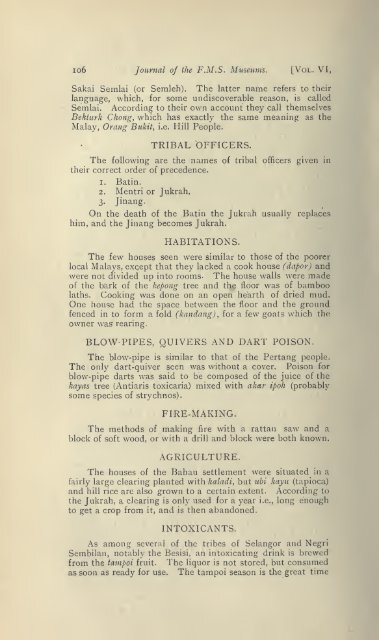Journal of the Federated Malay States museums - Sabrizain.org
Journal of the Federated Malay States museums - Sabrizain.org
Journal of the Federated Malay States museums - Sabrizain.org
Create successful ePaper yourself
Turn your PDF publications into a flip-book with our unique Google optimized e-Paper software.
io6 <strong>Journal</strong> <strong>of</strong> <strong>the</strong> F.M.S. Museums. [Vol. VI,<br />
Sakai Semlai (or Semleh). The latter name refers to <strong>the</strong>ir<br />
language, which, for some undiscoverable reason, is called<br />
Semlai. According to <strong>the</strong>ir own account <strong>the</strong>y call <strong>the</strong>mselves<br />
Bekturk CJiong, which has exactly <strong>the</strong> same meaning as <strong>the</strong><br />
<strong>Malay</strong>, Orang Bukit, i.e. Hill People.<br />
TRIBAL OFFICERS.<br />
The following are <strong>the</strong> names <strong>of</strong> tribal <strong>of</strong>ficers given in<br />
<strong>the</strong>ir correct order <strong>of</strong> precedence.<br />
1. Batin.<br />
2. Mentri or Jukrah,<br />
Jinang.<br />
3.<br />
On <strong>the</strong> death <strong>of</strong> <strong>the</strong> Batin <strong>the</strong> Jukrah usually replaces<br />
him, and <strong>the</strong> Jinang becomes Jukrah.<br />
HABITATIONS.<br />
The few houses seen were similar to those <strong>of</strong> <strong>the</strong> poorer<br />
local <strong>Malay</strong>s, except that <strong>the</strong>y lacked a cook house (dapor) and<br />
were not divided up into rooms. The house walls were made<br />
<strong>of</strong> <strong>the</strong> bark <strong>of</strong> <strong>the</strong> kepong tree and <strong>the</strong> floor was <strong>of</strong> bamboo<br />
laths. Cooking was done on an open hearth <strong>of</strong> dried mud.<br />
One house had <strong>the</strong> space between <strong>the</strong> floor and <strong>the</strong> ground<br />
fenced in to form a fold (kandang) , for a few goats which <strong>the</strong><br />
owner was rearing.<br />
BLOW-PIPES, QUIVERS AND DART POISON.<br />
The blow-pipe is similar to that <strong>of</strong> <strong>the</strong> Pertang people.<br />
The only dart-quiver seen was without a cover. Poison for<br />
blow-pipe darts was said to be composed <strong>of</strong> <strong>the</strong> juice <strong>of</strong> <strong>the</strong><br />
kayas tree (Antiaris toxicaria) mixed with akar ipoh (probably<br />
some species <strong>of</strong> strychnos).<br />
FIRE-MAKING.<br />
The methods <strong>of</strong> making fire with a rattan saw and a<br />
block <strong>of</strong> s<strong>of</strong>t wood, or with a drill and block were both known.<br />
AGRICULTURE.<br />
The houses <strong>of</strong> <strong>the</strong> Bahau settlement were situated in a<br />
fairly large clearing planted with kaladi, but tibi kayii (tapioca)<br />
and hill rice are also grown to a certain extent. According to<br />
<strong>the</strong> Jukrah, a clearing is only used for a year i.e., long enough<br />
to get a crop from it, and is <strong>the</strong>n abandoned.<br />
INTOXICANTS.<br />
As among several <strong>of</strong> <strong>the</strong> tribes <strong>of</strong> Selangor and Negri<br />
Sembilan, notably <strong>the</strong> Besisi, an intoxicating drink is brewed<br />
from <strong>the</strong> tanipoi fruit. The liquor is not stored, but consumed<br />
as soon as ready for use. The tampoi season is <strong>the</strong> great time

















